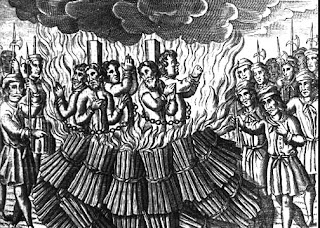 |
| From a feast at the University of Rochester |
The version we use most often today (there are slight variations, including a version for serving poultry) was recorded in a book of Christmas carols printed in 1521. It has been a popular carol—and a Yuletide event—ever since.
At least one scholar links it to a Norse tradition brought to England with the Anglo-Saxons. Sacrificing a boar to Freyr, a Norse god amenable to mortals, was supposed to bring peace and prosperity in the new year.
There's another origin for the choice of a boar, which has a slight hint in a line in the carol itself. In a book about Christmas carols printed in 1868, we can read the following:
Where an amusing tradition formerly current in Oxford concerning the boar's head custom, which represented that usage as a commemoration of an act of valour performed by a student of the college, who, while walking in the neighbouring forest of Shotover and reading Aristotle, was suddenly attacked by a wild boar. The furious beast came open-mouthed upon the youth, who, however, very courageously, and with a happy presence of mind, thrust the volume he was reading down the boar's throat, crying, "Græcum est," [Latin: "compliments of the Greeks"] and fairly choked the savage with the sage. [Husk, William Henry. Songs of the Nativity Being Christmas Carols, Ancient and Modern]I have included translations of the Latin lines below. The final one refers to Queen's College in Oxford. Husk was the librarian at Queen's College.
The boar's head in hand bear I,
Bedeck'd with bays and rosemary.
And I pray you, my masters, be merry
Quot estis in convivio [You who all feast in harmony]
CHORUS
Caput apri defero [The boar's head bear I]
Reddens laudes Domino [Singing praise to God]
The boar's head, as I understand,
Is the rarest dish in all this land,
Which thus bedeck'd with a gay garland
Let us servire cantico. [serve with a song]
CHORUS
Our steward hath provided this
In honour of the King of Bliss;
Which on this day to be servèd is
In Reginensi atrio. [in the Queen's hall]

































